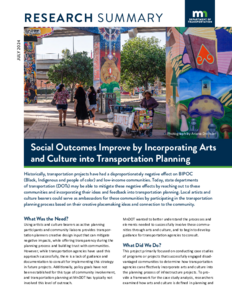Displaying results 1 - 9 of 9
Partners for Good: A Resource Guide for Partnership Efforts in Minnesota Cities and Counties
Creator
Date Created
2005
Report Number
2005-11
Description
Managing Utility Congestion Within Rights-of-Way
Creator
Date Created
2019-12
Report Number
2019RIC20
Description
Best Practices for Managing Utility Congestion Within Rights-of-Way
Date Created
2020-02
Report Number
2019RIC20G
Description
Appendices for Managing Utility Congestion Within Rights-of-Way
Creator
Date Created
2019-12
Report Number
2019RIC20A
Description
Utilizing Arts and Culture to Mitigate the Negative Impacts of Transportation Infrastructure on Communities
Date Created
2024-06
Report Number
2024-12
Description









